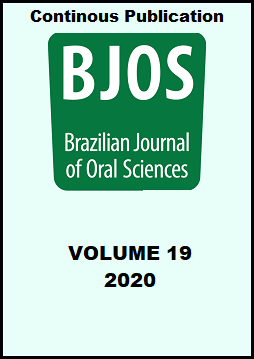Abstract
Aim: Little is known about the reparability of glass ionomer cements (GICs) after storage in acid environments. The aim of this study was to evaluate the solubility and repairability of GICs immersed in acid solutions and subjected to brushing. Methods: Thirty discs of each GIC (Vitremer, VitroFil LC, VitroFil, and Maxxion R) were divided into three immersion groups: distilled water, Coca-Cola, or hydrochloric acid (HCl), then subjected to brushing. The weight of discs was measured before and after the immersions to determine mass alteration. Each disc was repaired, by adding the same brand of GIC over its surface. After immersing the repaired specimens in same solutions, shear bond strengths using universal testing machine were measured. Two-way ANOVA and Tukey’s test was used (α=0.05). Results: Resin-modified GICs degrade after HCl immersion followed by brushing (p<0.05), while self-cured GICs were negatively affected by all challenges (p<0.05). The challenges decreased the repair strength for VitroFil LC (p<0.05), which had higher repair shear bond strength than the other GICs (p<0.05), exhibiting most cohesive failures. Conclusion: Self-cured GICs degraded when immersed in all acid solutions with brushing while resin-modified GICs only degraded following HCl immersion with brushing. Despite exhibiting the best repair results, VitroFil LC was the only GIC that was influenced by all the acid challenges.
References
Dursun E, Güncü GN, Dursun CK, Kiremitçi A, Karabulut E, Akalın FA. Nanofilled and conventional resin-modified glass ionomer fillings combined with connective tissue grafts for treatment of gingival recessions with non-carious cervical lesions. J Oral Sci. 2018 Sep 23;60(3):344-51. doi: 10.2334/josnusd.17-0190.
Anhesini BH, Landmayer K, Nahsan FPS, Pereira JC, Honório HM, Francisconi-Dos-Rios LF. Composite vs. ionomer vs. mixed restoration of wedge-shaped dental cervical lesions: Marginal quality relative to eccentric occlusal loading. J Mech Behav Biomed Mater. 2019 Mar;91:309-14. doi: 10.1016/j.jmbbm.2018.12.034.
Alvarez-Arenal A, Alvarez-Menendez L, Gonzalez-Gonzalez I, Alvarez-Riesgo JA, Brizuela-Velasco A, de Llanos-Lanchares H. Non-carious cervical lesions and risk factors: A case-control study. J Oral Rehabil. 2019 Jan;46(1):65-75. doi: 10.1111/joor.12721.
Rios D, Honório HM, Francisconi LF, Magalhães AC, de Andrade Moreira Machado MA, Buzalaf MA. In situ effect of an erosive challenge on different restorative materials and on enamel adjacent to these materials. J Dent. 2008 Feb;36(2):152-7. doi: 10.1016/j.jdent.2007.11.013.
Sidhu SK. Clinical evaluations of resin-modified glass-ionomer restorations. Dent Mater. 2010 Jan;26(1):7-12. doi: 10.1016/j.dental.2009.08.015.
Kanzow P, Wiegand A, Schwendicke F. Cost-effectiveness of repairing versus replacing composite or amalgam restorations. J Dent. 2016 Nov;54:41-7. doi: 10.1016/j.jdent.2016.08.008
Maneenut C, Sakoolnamarka R, Tyas MJ. The repair potential of resin-modified glass-ionomer cements. Dent Mater. 2010 Jul;26(7):659-65. doi: 10.1016/j.dental.2010.03.009.
International Organization of Standardization – ISO. Dentistry — Water-based cements — Part 1: Powder/liquid acid-base cements. ISO 9917-1:2007. p.1-22.
Briso AL, Caruzo LP, GuedesAP, Catelan A, dos Santos PH. In vitro evaluation of surface roughness and microhardness of restorative materials submitted to erosive challenges. Oper Dent. 2011 Jul-Aug;36(4):397-402. doi: 10.2341/10-356-L.
de Paula AB, de Fúcio SB, Alonso RC, Ambrosano GM, Puppin-Rontani RM. Influence of chemical degradation on the surface properties of nano restorative materials. Oper Dent. 2014 May-Jun;39(3):E109-17. doi: 10.2341/12-340.
Hamouda IM. Effects of various beverages on hardness, roughness, and solubility of esthetic restorative materials. J Esthet Restor Dent. 2011 Oct;23(5):315-22. doi: 10.1111/j.1708-8240.2011.00453.x.
Meşe A, Burrow MF, Tyas MJ. Sorption and solubility of luting cements in different solutions. Dent Mater J. 2008 Sep;27(5):702-9.
Voltarelli FR, Santos-Daroz CB, Alves MC, Cavalcanti AN, Marchi GM. Effect of chemical degradation followed by toothbrushing on the surface roughness of restorative composites. J Appl Oral Sci. 2010 Dec;18(6):585-90.
Eisenburger M, Addy M, Rossbach A. Acidic solubility of luting cements. J Dent. 2003 Feb;31(2):137-42.
Calvo AF, Kicuti A, Tedesco TK, Braga MM, Raggio DP. Evaluation of the relationship between the cost and properties of glass ionomer cements indicated for atraumatic restorative treatment. Braz Oral Res. 2016;30. pii: S1806-83242016000100201. doi: 10.1590/1807-3107BOR-2016.vol30.0008.
Hazar-Yoruc B, Bavbek AB, Özcan M. The erosion kinetics of conventional and resin-modified glass-ionomer luting cements in acidic buffer solutions. Dent Mater J. 2012;31(6):1068-74.
Gray JA. Kinetics of enamel dissolution during formation of incipient caries-like lesions. Arch Oral Biol. 1966 Apr;11(4):397-422.
Aliping-McKenzie M, Linden RW, Nicholson JW. The effect of Coca-Cola and fruit juices on the surface hardness of glass-ionomers and 'compomers'. J Oral Rehabil. 2004 Nov;31(11):1046-52.
Martos J, Silveira LF, Silveira CF, de Castro LA, Ferrer-Luque CM. The effect of different organic solvents on the degradation of restorative materials. Eur J Dent. 2013 Jul;7(3):347-51. doi: 10.4103/1305-7456.115419.
Cattani-Lorente MA, Dupuis V, Payan J, Moya F, Meyer JM. Effect of water on the physical properties of resin-modified glass ionomer cements. Dent Mater. 1999 Jan;15(1):71-8.
Mallmann A, Ataíde JC, Amoedo R, Rocha PV, Jacques LB. Compressive strength of glass ionomer cements using different specimen dimensions. Braz Oral Res. 2007 Jul-Sep;21(3):204-8.
Fonseca RB, Branco CA, Quagliatto PS, Gonçalves Lde S, Soares CJ, Carlo HL, et al. Influence of powder/liquid ratio on the radiodensity and diametral tensile strength of glass ionomer cements. J Appl Oral Sci. 2010 Dec;18(6):577-84.
Kerby RE, Knobloch L. The relative shear bond strength of visible light-curing and chemically curing glass-ionomer cement to composite resin. Quintessence Int. 1992 Sep;23(9):641-4.
Yap AU, Lye KW, Sau CW. Effects of aging on repair of resin-modified glass-ionomer cements. J Oral Rehabil. 2000 May;27(5):422-7.
Nassar HM, Platt JA. Effect of brushing with two different abrasives on fluoride release by high-viscosity glass ionomer cement. J Oral Sci. 2015;57(4):379-84. doi: 10.2334/josnusd.57.379.
Lemos CA, Mauro SJ, Dos Santos PH, Briso AL, Fagundes TC. Influence of Mechanical and Chemical Degradation in the Surface Roughness, Gloss, and Color of Microhybrid Composites. J Contemp Dent Pract. 2017 Apr 1;18(4):283-8.
Torres CRG, da silva TM, Sales ALLS, Pucci CR, Borges AB. Influence of chemical degradation and toothbrushing on surface of composites. World J Dent. 2015 Apr/Jun;6(2):65-70. doi: 10.5005/jp-journals-10015-1316.
The Brazilian Journal of Oral Sciences uses the Creative Commons license (CC), thus preserving the integrity of the articles in an open access environment.


